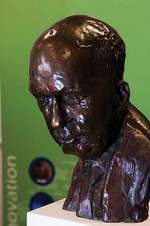Famous son comes "home" with help from royalty
 Alumni Alumni
A bust to commemorate one of Adelaide's most distinguished sons - world-famous scientist Sir William Lawrence Bragg - has been unveiled by His Royal Highness the Duke of Kent at the University of Adelaide. Sir William Lawrence Bragg (Lawrence) graduated from the University of Adelaide in mathematics in 1908, and in 1915 won the Nobel Prize jointly with his father, Sir William Henry Bragg. Together they worked out how to determine the molecular structure of crystals using x-rays. Lawrence Bragg remains the youngest scientist ever to win the Nobel Prize, at 25. The bronze bust by sculptor John Mills is a twin to that located in the Royal Institution of Great Britain, cast especially for the University of Adelaide. Another bust will be located at St Peter's College where Lawrence Bragg went to school, yet another is with the Cavendish Laboratory at the University of Cambridge, and a fifth is with the Bragg family. HRH the Duke of Kent, who is President of the Royal Institution of Great Britain, was in Adelaide to launch the new Royal Institution of Australia, of which he will be Patron. Both Lawrence and William Bragg had been Directors of the Royal Institution. "It is a great honour to welcome the Duke of Kent to the University of Adelaide and for him to see where the work of these famous scientists, William and Lawrence Bragg, began," said the Vice-Chancellor and President, Professor James McWha. "The University of Adelaide is extremely proud to have been involved in the education and research of these great minds, whose work touches many
aspects of all of our lives, almost 100 years on." "Bragg's Law" is fundamental to the determination of the molecular structure of materials. The Braggs' work has had an enormous impact across modern science and its applications, in medicine, physics, chemistry and biological sciences, including determining the structures of proteins and DNA. Their techniques are routinely used in many industries, including the development of new drugs and chemicals and in the minerals industry. For example, the Bragg techniques were used to develop the anti-influenza drug Relenza, which was developed in Australia using the x-ray crystal structural work of another University of Adelaide graduate and Australia Prize-winning scientist, Professor Peter Colman. At the University's School of Chemistry and Physics, the Duke of Kent signed the same University of Adelaide visitors book signed in 1901 by his grandfather, who laid the foundation stone for Elder Hall on that visit, and who later became King George V. The Duke also saw some of the legacy of the Bragg research, highlighted in the SA Partnership for Advanced Computing's Visualisation Laboratory, then unveiled the bronze bust of Sir William Lawrence Bragg before viewing Bragg memorabilia and meeting staff and students. Sir William Henry Bragg spent 22 years at the University of Adelaide as Elder Professor of Mathematics and Physics from 1886 to 1908, and his pioneering work with x-rays and radium started at Adelaide. Story by Robyn Mills
|






